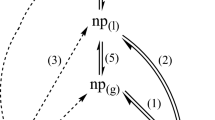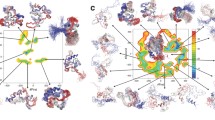Abstract
Large increases in the strength of the hydrophobic effect and, consequently, in the estimates of the hydrophobic contribution to the thermodynamics of protein folding (and other biologically-relevant processes), have been recently advocated on the basis of the application, to model transfer thermodynamic data, of corrections for the solute/solvent size disparity. In this work we first examine the effect of molecular-size corrections on the values calculated from several types of model transfer data. For the transfer of a solute from an organic solvent to water, the above increase is exclusively associated with the application of a solute/water molecular-size correction. Secondly, we critically review and assess the several theoretical arguments that lead to these corrections. In particular, we show that, contrary to previous claims in the literature, the analysis of dissolution processes in terms of ideal-gas, intermediate states does not lead to the molecular-size correction term, but only to expressions equivalent (although not strictly identical) to those derived from the well-known Ben-Naim's statistical-mechanical approach. In general, the several analyses offered or discussed in this work disfavor the application of the solute/water molecular-size corrections.
Similar content being viewed by others
References
Abraham MH, Sakellariou P (1994) The Honig-Flory-Huggins Entropy correction-Is it valid for aqueous solutions? J Chem Soc Perkin Trans 2:405–406
Baker D, Chan HS, Dill KA (1993) Coordinate space formulation of polymer lattice cluster theory. J Chem Phys 98:9951–9962
Ben-Naim A (1978) Standard thermodynamics of transfer. Uses and misuses. J Phys Chem 82:792–803
Ben-Naim A (1987) Is mixing a thermodynamic process? Am J Phys 55:725–733
Ben-Naim A (1990) Solvent effects on protein association and protein folding. Biopolymers 29:567–596
Ben-Naim A (1992) Statistical thermodynamics for chemists and biochemists. Plenum Press, New York London
Ben-Naim A (1994) Solvation of large molecules: some exact results on the dependence on volume and surface area of the solute. Biophys Chem 51:203–216
Ben-Naim A, Mazo RM (1993) Size dependence of the solvation free energies of large solutes. J Phys Chem 97:10829–10834
Blokzijl W, Engberts JBFN (1993) Hydrophobic effects. Opinions and facts. Angew Chem Int Ed Engl 32:1545–1579
Chan HS, Dill KA (1994) Solvation: effects of molecular size and shape. J Chem Phys 101:7007–7026
Creighton TE (1991) Stability of folded conformations. Current Opin Struct Biol 1:5–16
De Young L, Dill KA (1990) Partitioning of nonpolar solutes into bilayers and amorphous n-alkanes. J Phys Chem 94:801–809
Denbigh K (1981) The principles of chemical equilibrium, 4th edn. Cambridge University Press, Cambridge
Dill KA (1990) Dominant forces in protein folding. Biochemistry 29:7133–7155
Fauchere JL, Pliska VE (1983) Hydrophobic parameters of amino acid side-chains from the partitioning of N-acetyl-amino-acid amines. Eur J Med Chem 18:369–375
Flory PJ (1941) Thermodynamics of high polymer solutions. J Chem Phys 9:660–661
Freed KF (1985) New lattice model for interacting, avoiding polymers with controlled length distribution. J Phys A 18:871–887
Freed KF, Bawendi MG (1989) Lattice theories of polymeric fluids. J Phys Chem 93:2194–2203
Giesen DJ, Cramer CJ, Truhlar DG (1994) Entropic contributions to free energies of solvation. J Phys Chem 98:4141–4147
Hermann RB (1972) Theory of hydrophobic bonding. II The correlation of hydrocarbon solubility in water with solvent cavity surface area. J Phys Chem 76:2754–2759
Hill TL (1956) Statistical mechanics. Principles and selected applications. McGraw-Hill, New York
Holtzer A (1992) The use of Flory-Huggins theory in interpreting partitioning of solutes between organic liquids and water. Biopolymers 32:711–715
Huggins ML (1941) Solutions of long chain compounds. J Chem Phys 9:440–449
Lazaridis T, Paulaities ME (1992) Entropy of hydrophobic hydration: a new statistical mechanical formulation. J Phys Chem 96:3847–3855
Lazaridis T, Paulaities ME (1993) Reply to the comment on “Entropy of hydrophobic hydration: a new statistical mechanical formulation”. J Phys Chem 97:5789–5790
Lee B (1994) Relation between volume correction and the standard state. Biophys Chem 51:263–269
Levitt M, Perutz MF (1988) Aromatic rings act as hydrogen bonds acceptors. J Mol Biol 201:751–754
Makhatadze GI, Privalov PL (1990) Heat capacity of proteins. I. Partial molar heat capacity of individual amino acid residues in aqueous solutions. Hydration effect. J Mol Biol 213:375–384
Makhatadze GI, Privalov PL (1993) Contribution of hydration to protein folding thermodynamics. I. The enthalpy of hydration. J Mol Biol 232:639–659
Makhatadze GI, Privalov PL (1994) Hydration effects in protein unfolding. Biophys Chem 51:291–309
Makhatadze GI, Privalov PL (1995) Energetics of protein structure. Adv Prot Chem (in press)
Murphy KP, Gill SJ (1991) Solid model compounds and the thermodynamics of protein unfolding. J Mol Biol 222:699–709
Pettitt BM (1994a) Integral equation approaches to structure and thermodynamics of aqueous salt solutions. Biophys Chem 51:129–146
Perkyns J, Pettitt BM (1994b) Discussion to the paper to by A. Ben-Naim. Biophys Chem 51:214
Privalov PL, Gill SJ (1988) Stability of protein structure and hydrophobic interaction. Adv Prot Chem 39:191–234
Privalov PL, Makhatadze GI (1990) Heat capacity of proteins. 11. Partial molar heat capacity of the unfolded polypeptide chain of proteins. J Mol Biol 213:385–391
Privalov PL, Makhatadze GI (1992) Contribution of hydration and non-covalent interactions to the heat capacity effect on protein unfolding. J Mol Biol 224:715–723
Privalov PL, Makhatadze GI (1993) Contribution of hydration to protein folding thermodynamics. II. The entropy of hydration. J Mol Biol 232:660–679
Rashin AA (1993) Aspects of protein energetics and dynamics. Prog Biophys Mol Biol 60:73–200
Rashin AA, Bukatin MA (1994a) Magnitude of hydration entropies of nonpolar and polar molecules. J Phys Chem 98:386–389
Rashin AA, Bukatin MA (1994b) A view of thermodynamics of hydration emerging from continuum models. Biophys Chem 51:167–192
Rodham DA, Suzuki S, Suenram RD, Lovas FJ, Dasgupta S, Goddard WA, Blake GA (1993) Hydrogen bonding in the benzeneammonia dimer. Nature 362:735–737
Sharp KA (1991) The hydrophobic effect. Current Opin Struct Biol 1:171–174
Sharp KA, Nicholls A, Fine RF, Honig B (1991a) Reconciling the magnitude of the microscopic and macroscopic hydrophobic effects. Science 252:106–109
Sharp KA, Nicholls A, Friedman R, Honig B (1991b) Extracting hydrophobic free energies from experimental data: relationship to protein folding and theoretical models. Biochemistry 30:9686–9697
Simonson T, Brunger AT (1994) Solvation free energies estimated from macroscopic continuum models: an accuracy assessment. J Phys Chem 98:4683–4694
Sitkoff D, Sharp K, Honig B (1994) Correlating solvation free energies and surface tensions of hydrocarbon solutes. Biophys Chem 51:397–409
Smith DE, Brian BL, Haymet ADJ (1993) Comment on “Entropy of hydrophobic hydration: a new statistical mechanical formulation”. J Phys Chem 97:5788
Sun Y, Spellmeyer D, Pearlman DA, Kollman P (1992) Simulation of the solvation free energies for methane, ethane, and propane and corresponding amino acid dipeptides: a critical test of the “bond-PMF” correction, a new set of hydrocarbon parameters, and the gas phase-water hydrophobicity scale. J Am Chem Soc 114:6798–6801
Suzuki S, Green PG, Bumgarner RE, Dasgupta S, Goddard WA, Blake GA (1992) Benzene forms hydrogen bonds with water. Science 257:942–945
Tuñon I, Silla E, Pascual-Ahuir JL (1993) Continuum-uniform approach calculations of the solubility of hydrocarbons in water. Chem Phys Lett 203:289–294
Tuñon I, Silla E, Pascual-Ahuir JL (1994) Evaluation of transfer energies. J Phys Chem 98:377–379
Author information
Authors and Affiliations
Rights and permissions
About this article
Cite this article
Sanchez-Ruiz, J.M. Molecular-size corrections to the strength of the hydrophobic effect: a critical review. Eur Biophys J 24, 261–274 (1996). https://doi.org/10.1007/BF00205107
Received:
Accepted:
Issue Date:
DOI: https://doi.org/10.1007/BF00205107




